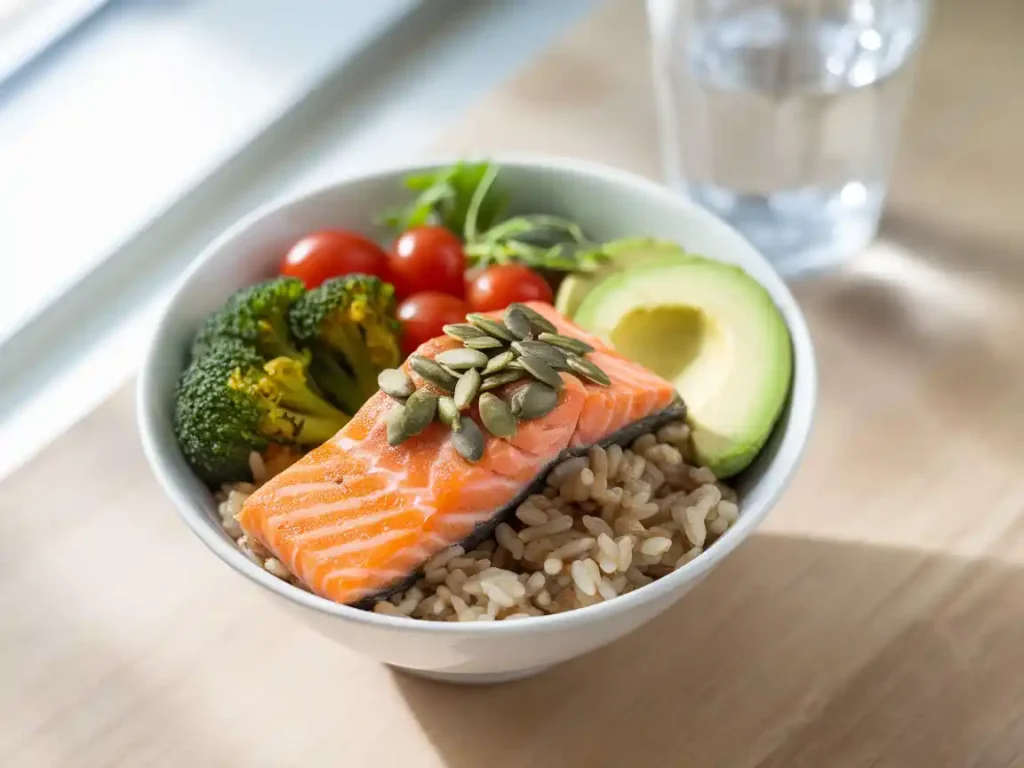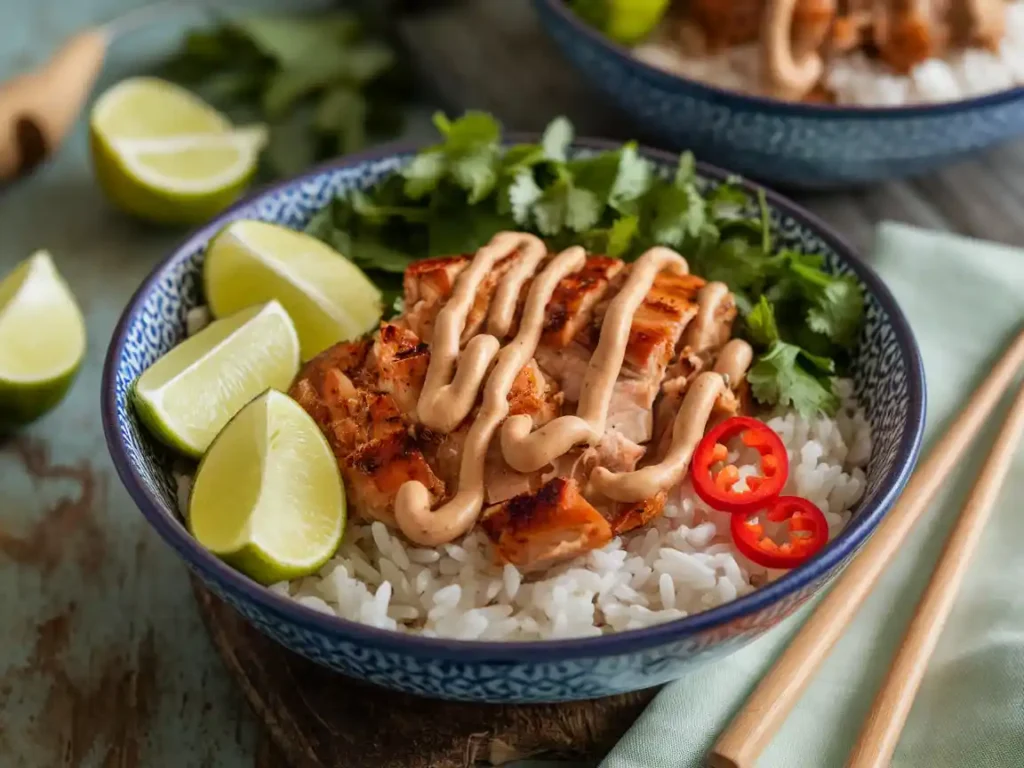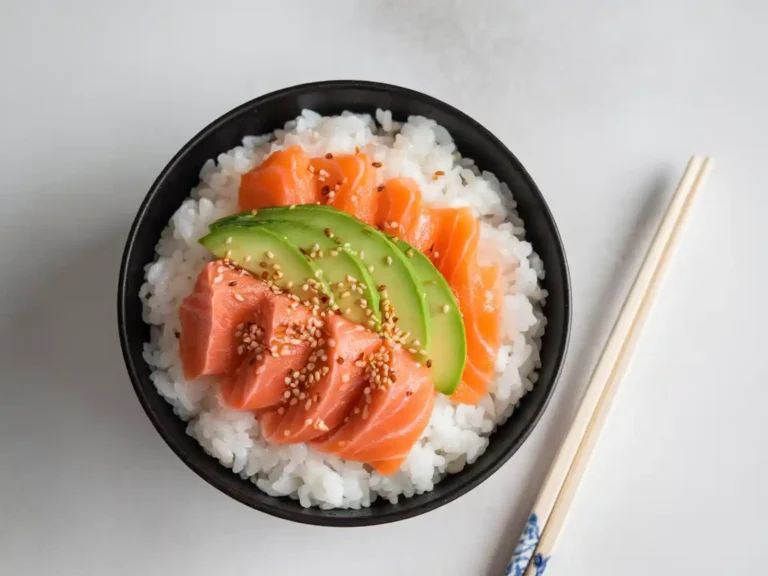Rice bowls are incredibly popular worldwide for their simplicity, nutrition, and endless customization options. At their core, rice bowls are all about combining fluffy or sticky rice with a mix of proteins, vegetables, and flavorful sauces. They’re a balanced meal that satisfies both your hunger and your taste buds.
From Japanese donburi to Korean bibimbap, rice bowls have deep cultural roots, yet they’ve become a global food trend. They’re not only delicious but also easy to make. The magic, however, lies in choosing the right rice.
Why? Because rice isn’t just a filler it’s the foundation of the entire bowl. The wrong kind of rice can ruin the texture, flavor, and presentation. So let’s break it down and find the perfect rice for every type of rice bowl.
Table of Contents
Why Choosing the Right Rice Matters for Rice Bowls
If you’ve ever made a rice bowl and felt something was “off,” the culprit is often the rice itself. Many people think all rice is the same, but that couldn’t be further from the truth. The type of rice you choose determines:
- Texture: Is the rice sticky and clumpy or light and fluffy?
- Flavor Absorption: Can it soak up sauces and seasonings well?
- Presentation: Does it look appetizing and hold its shape in the bowl?
For rice bowls, texture is everything. Sticky rice holds toppings together, while fluffy rice creates a delicate base for saucy dishes.
“The rice you choose can elevate your bowl from average to restaurant-quality. It’s the unsung hero that ties everything together.”
Additionally, using the wrong type of rice can lead to common cooking problems like mushiness or undercooked grains. But don’t worry I’ll guide you step-by-step to pick the best rice and cook it perfectly every time.
Types of Rice Commonly Used in Rice Bowls

When it comes to rice bowls, not all rice is created equal. Different types of rice deliver different results, and knowing which one to use will help you achieve the perfect bowl. Here are the most popular rice varieties for rice bowls:
Short-Grain Rice: The Sticky Option for Perfect Texture
Short-grain rice is the king of rice bowls when it comes to stickiness. It’s commonly used in Japanese and Korean dishes where clumpy, sticky rice is essential. Think of sushi rice or Korean bibimbap both rely on short-grain rice’s ability to hold together.
- Texture: Soft, sticky, and clumpy.
- Flavor: Slightly sweet and mild, perfect for absorbing sauces.
- Best Uses: Sushi bowls, donburi, bibimbap, and poke bowls.
Short-grain rice is often labeled as “sushi rice” in stores. Its stickiness holds toppings together, making it ideal for bowls with lots of mix-ins and sauce.
“Short-grain rice is like glue it brings everything in your bowl together in one perfect bite.”
Medium-Grain Rice: The Versatile Choice for Bowls
Medium-grain rice strikes a balance between sticky and fluffy, making it a versatile option for rice bowls. It’s slightly less sticky than short-grain rice but still holds its shape well.
- Texture: Soft, tender, and slightly sticky.
- Flavor: Mild, allowing other flavors to shine.
- Best Uses: Rice bowls with hearty proteins, casseroles, and dishes like paella.
Medium-grain rice is often used in Mediterranean rice bowls or Latin-inspired dishes. If you’re unsure which rice to use, medium-grain rice is a safe and adaptable choice.
Long-Grain Rice: The Light and Fluffy Alternative
Long-grain rice, such as Basmati or Jasmine rice, is the go-to option for bowls where fluffiness is key. This rice has long, separate grains and a light texture that pairs beautifully with saucy or spiced dishes.
- Texture: Light, fluffy, and non-sticky.
- Flavor: Mild with subtle nutty or floral notes (depending on the variety).
- Best Uses: Thai rice bowls, Indian-inspired rice bowls, and grain salads.
For example, Jasmine rice is perfect for a Thai rice bowl topped with grilled chicken, fresh herbs, and peanut sauce. It adds a light and fragrant base without overwhelming the toppings.
Specialty Rice Varieties for Unique Flavors
If you want to level up your rice bowl game, consider specialty rice varieties that offer unique flavors and textures:
- Brown Rice: A healthier alternative packed with fiber and a slightly nutty flavor .
- Wild Rice: Earthy, chewy, and great for adding texture to rice bowls.
- Black Rice (Forbidden Rice): Packed with antioxidants, this rice adds a stunning visual contrast to bowls.
Each of these specialty rice varieties brings something special to the table. Brown rice, for instance, works well for health-conscious rice bowls, while black rice adds drama and nutrition.
Factors to Consider When Choosing Rice
When picking the best rice for your rice bowls, it’s not just about variety it’s about choosing the right rice to match your dish. The texture, flavor, and nutritional value can make a huge difference in the final result. Here are the most important factors to keep in mind:
Texture: Sticky, Fluffy, or Creamy?
The texture of rice is a game-changer for rice bowls. Different cuisines call for different textures, and getting it right makes all the difference:
- Sticky Texture: Essential for dishes like Japanese sushi bowls or Korean bibimbap. Sticky rice holds toppings together and creates satisfying bites.
- Fluffy Texture: Perfect for rice bowls with saucy toppings or dry rub proteins, like Thai rice bowls or poke bowls with Jasmine rice.
- Creamy Texture: This is less common for rice bowls but works beautifully for comfort food bowls with risotto-style rice.
If you’re making a Japanese or Korean bowl, stick with short-grain rice. For lighter, fluffier bowls, long-grain rice like Jasmine or Basmati is ideal. Think of the rice as a canvas its texture will define how the rest of the dish comes together.
“Texture is the foundation of a great rice bowl. Choose sticky rice for cohesion, fluffy rice for contrast, and creamy rice for indulgence.”
Flavor Absorption and Aroma
The best rice doesn’t just sit under your toppings it soaks up flavors and complements the dish. Some rice varieties are more neutral, while others carry distinctive aromas that add depth.
- Neutral Rice: Short-grain and medium-grain rice have a mild flavor that works well with bold toppings and sauces.
- Aromatic Rice: Jasmine and Basmati rice have subtle floral or nutty aromas, enhancing the overall flavor profile of your rice bowl.
For example, Jasmine rice pairs beautifully with Thai-inspired bowls because its natural fragrance enhances the spices and sauces. On the other hand, short-grain sushi rice absorbs the delicate acidity of rice vinegar in Japanese bowls.
Nutritional Value of Different Rice Types
Choosing the right rice can also depend on your health and dietary needs. While white rice is the most popular choice for rice bowls, other options provide additional nutrients:
- White Rice: The classic choice, easy to digest, and versatile.
- Brown Rice: Rich in fiber, vitamins, and minerals; it’s a great choice for health-conscious rice bowls.
- Wild Rice: A high-protein, nutrient-dense option with a chewy texture.
- Black Rice: Packed with antioxidants and slightly sweet, it’s a nutrient powerhouse.
If you’re looking to add more fiber and nutrients to your diet, switching to brown or black rice can transform your rice bowls into a healthier option without sacrificing taste.
“Healthy rice choices like brown and black rice can take your rice bowls to the next level, offering both flavor and nutrition.” 🌾
Best Types of Rice for Popular Rice Bowls

The beauty of rice bowls lies in their diversity. Different cuisines use specific types of rice that suit their signature flavors and textures. Let’s explore the best rice for some of the most popular rice bowl varieties:
Sushi Rice for Japanese Rice Bowls
Japanese rice bowls, or donburi, require short-grain sushi rice, which is known for its sticky texture and mild flavor. It holds together perfectly for sushi-inspired bowls or toppings like sashimi, teriyaki chicken, or tempura.
- Why It Works: Sushi rice absorbs light flavors (like rice vinegar) without overpowering delicate toppings.
- How to Use It: Rinse the rice thoroughly before cooking to remove excess starch, then season lightly with rice vinegar and salt.
Perfect Pairings: Fresh sashimi, avocado, cucumber, nori (seaweed), and soy sauce. 🍣
Jasmine Rice for Thai and Southeast Asian Bowls
Jasmine rice is a staple in Thai and Southeast Asian cuisine. Its long grains are fluffy, slightly sticky, and carry a subtle floral aroma that complements vibrant, spiced dishes.
- Why It Works: The fragrant grains add a delicate base for Thai curries, grilled meats, or spicy sauces.
- How to Use It: Steam Jasmine rice to preserve its fragrance and fluffiness.
Perfect Pairings: Grilled chicken, Thai basil, peanut sauce, chili flakes, and fresh herbs. 🌿
Basmati Rice for Indian and Middle Eastern Bowls
Basmati rice is a long-grain variety known for its light texture and nutty aroma. It’s a perfect match for Indian and Middle Eastern rice bowls, especially those with spiced or marinated proteins.
- Why It Works: Basmati rice stays separate when cooked, creating an airy base for heavily spiced or saucy dishes.
- How to Use It: Rinse Basmati rice well before cooking to remove starch and ensure fluffy grains.
Perfect Pairings: Tandoori chicken, chickpea curry, roasted vegetables, and yogurt sauce. 🌶️
Brown Rice for Health-Conscious Rice Bowls
If you’re focused on nutrition, brown rice is the best option. It’s a whole-grain rice with a nutty flavor and chewy texture that works well in hearty rice bowls.
- Why It Works: Brown rice adds fiber, vitamins, and a robust texture that’s perfect for balanced, nutritious meals.
- How to Use It: Brown rice takes longer to cook than white rice, so plan accordingly (or use a rice cooker for convenience).
Perfect Pairings: Grilled salmon, avocado, roasted broccoli, and tahini sauce. 🥦
Wild Rice for Nutty and Textured Bowls
Wild rice isn’t technically rice it’s a seed from aquatic grass but it adds a nutty flavor and chewy texture that makes it ideal for grain bowls.
- Why It Works: It’s nutrient-dense, high in protein, and adds texture to rice bowls.
- How to Use It: Combine wild rice with other rice varieties for added texture and flavor.
Perfect Pairings: Grilled mushrooms, kale, dried cranberries, and a lemon vinaigrette. 🍋
Cooking Techniques
Once you’ve chosen the right type of rice, it’s time to cook it to perfection. The cooking technique you use can make or break the final dish, so here’s how to get it just right:
H3: How to Cook Perfect Short-Grain Rice
Short-grain rice requires careful attention to achieve its sticky texture:
- Rinse Thoroughly: Wash the rice under cold water until the water runs clear.
- Use the Right Water Ratio: For every 1 cup of short-grain rice, use 1.2 cups of water.
- Cook Gently: Bring to a boil, then simmer on low heat with the lid on for 15 minutes.
- Rest: Let the rice rest for 10 minutes before fluffing it with a wooden spoon.
How to Prepare Fluffy Long-Grain Rice
Long-grain rice, like Basmati or Jasmine, needs a different approach:
- Rinse to Remove Starch: Rinse the rice until the water is no longer cloudy.
- Water Ratio: Use 1.5 cups of water for every 1 cup of long-grain rice.
- Cook and Steam: Simmer on low heat with the lid on for 12-15 minutes.
The result? Light, separate grains that work beautifully with sauces and toppings.
Steaming vs Boiling: Which Is Better?
- Steaming: Preserves the rice’s natural flavor and texture, making it ideal for sushi or Jasmine rice.
- Boiling: Faster and works well for fluffy rice, but it may require draining excess water.
Pro Tip: Use a rice cooker for consistent, hassle-free results every time.
Common Problems When Cooking Rice for Bowls
Even with the best rice and careful preparation, sometimes things go wrong. Mushy rice? Undercooked grains? Don’t worry these common issues have simple solutions that will save your dish every time.
Mushy Rice: Causes and Solutions
Mushy rice happens when you add too much water, overcook the rice, or stir it excessively while it’s cooking. Here’s how to fix it:
- Cause: Excess water absorbed by the grains.
- Solution: Spread the rice on a baking sheet and dry it out in the oven at a low temperature (around 250°F/120°C) for 5-10 minutes.
Prevention Tips:
- Use the correct water-to-rice ratio. Short-grain rice needs less water, while long-grain rice requires a bit more.
- Avoid constant stirring unless you’re making risotto.
- Let the rice rest after cooking it will absorb any excess moisture naturally.
Undercooked Rice: Troubleshooting Steps
Undercooked rice can ruin the texture of your rice bowl, leaving it hard and crunchy. Here’s how to fix it on the fly:
- Solution: Add a small amount of water (2-3 tablespoons) to the pot, cover it, and let the rice steam on low heat for another 5-10 minutes.
Prevention Tips:
- Keep the lid on during cooking to trap steam.
- Avoid checking the rice too often it disrupts the cooking process.
- Use a timer to ensure consistent results.
Achieving Consistent Texture in Every Bowl
Consistency is key when it comes to cooking rice for bowls. To achieve perfect texture every time:
- Rinse Your Rice: This removes excess starch and prevents clumping.
- Measure Properly: Stick to the right ratios 1:1.2 for short-grain rice and 1:1.5 for long-grain rice.
- Let It Rest: After cooking, let the rice sit for at least 10 minutes before fluffing it.
- Invest in a Rice Cooker: A rice cooker is a foolproof way to get consistent results without guesswork.
“Cooking rice is like baking it’s all about precision. Measure, monitor, and rest your rice for perfect results every time.”
Final Thoughts
Choosing the best rice for your rice bowls isn’t as complicated as it sounds. It all comes down to understanding the dish you’re making and matching it with the right rice variety. Short-grain rice delivers the perfect stickiness for sushi bowls, while long-grain Jasmine or Basmati rice works wonders in fluffy, aromatic bowls.
Whether you’re making a healthy brown rice bowl, a hearty poke bowl, or a fragrant Thai-inspired dish, the rice you choose sets the stage for an unforgettable meal.
At the end of the day, rice bowls are about balance balancing textures, flavors, and nutrients to create a meal that’s as delicious as it is satisfying. So, experiment with different types of rice and toppings, and find what works best for you. After all, the perfect rice bowl is one that makes you excited to dig in! 🍚
Frequently Asked Questions
What type of rice is best for sticky rice bowls?
Short-grain rice, such as sushi rice, is the best option for sticky rice bowls because of its high starch content, which creates a cohesive texture.
Can I use brown rice for rice bowls?
Absolutely! Brown rice adds a nutty flavor, extra fiber, and more nutrients, making it a healthy option for rice bowls.
How do I prevent my rice from turning mushy?
Use the correct water-to-rice ratio, avoid overcooking, and let the rice rest for 10 minutes after cooking to absorb excess moisture.
Is Jasmine rice good for rice bowls?
Yes, Jasmine rice is perfect for rice bowls where a light, fluffy texture and subtle floral aroma are desired, such as Thai or Southeast Asian dishes.
What’s the healthiest rice for rice bowls?
Brown rice, black rice, and wild rice are the healthiest options due to their high fiber, protein, and nutrient content.
Can I mix different types of rice in one bowl?
Yes! Combining rice varieties, like brown rice and wild rice, adds unique flavors, textures, and nutrients to your rice bowl.

